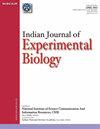Intensified biodegradation of Congo red dye by mixed culture in a sequential bioreactor: Kinetics and phytotoxicity studies
IF 0.7
4区 生物学
Q4 BIOLOGY
引用次数: 0
Abstract
Although textile industries lead the economic sector in several countries, the pollution that they cause, particularly to water bodies, is a serious environmental concern. Dyes and their metabolites are harmful to human and aquatic life due to their toxic, mutagenic, and carcinogenic potential. In this study, we have made an effort to treat the complex Congo red (CR) dye-containing wastewater in an anaerobic-aerobic sequential bioreactor. The impact of CR dye concentration (20-100 mg/L) on the performance of sequential bioreactor was examined. The CR dye removal efficiencies (REs) of 97, 88.1, 75.9, 68.7, and 42.56% were obtained at 20, 40, 60, 80 and 100 mg/L of CR dye, respectively. Similarly, the overall Chemical oxygen demand (COD) RE of 90% was also obtained. It was found that the CR dye and COD REs were high at low concentrations of CR dye. The obtained experimental data was fitted with growth and substrate inhibition models. A phytotoxic study indicated that the Chickpea (Cicer arietinum L.) grown in treated wastewater showed better germination (93%) than untreated wastewater (66%).顺序生物反应器中混合培养强化刚果红染料的生物降解:动力学和植物毒性研究
虽然纺织工业在若干国家的经济部门中占主导地位,但它们造成的污染,特别是对水体的污染,是一个严重的环境问题。染料及其代谢产物具有毒性、诱变性和致癌性,对人类和水生生物有害。在本研究中,我们尝试在厌氧-好氧序列生物反应器中处理含刚果红(CR)染料的复合废水。考察了CR染料浓度(20 ~ 100 mg/L)对序式生物反应器性能的影响。在CR染料浓度为20、40、60、80和100 mg/L时,CR染料去除率分别为97、88.1、75.9、68.7和42.56%。同样,总化学需氧量(COD) RE也达到90%。结果表明,在低浓度CR染料条件下,CR染料和COD REs较高。得到的实验数据符合生长和底物抑制模型。一项植物毒性研究表明,鹰嘴豆(Cicer arietinum L.)在处理后的废水中萌发率(93%)高于未处理的废水(66%)。
本文章由计算机程序翻译,如有差异,请以英文原文为准。
求助全文
约1分钟内获得全文
求助全文
来源期刊
CiteScore
1.57
自引率
33.30%
发文量
84
审稿时长
6 months
期刊介绍:
This journal, started in 1963, publishes full papers, notes and reviews in cell biology, molecular biology, genetic engineering, endocrinology, reproductive biology, immunology, developmental biology, comparative physiology, radiation biology, chronobiology, microbiology, pharmacology, toxicology and other biological fields including instrumentation and methodology. The papers having experimental design involving alteration and/or manipulation in biological system(s) providing insight into their functioning are considered for publication. Studies involving higher animals, human beings and of clinical nature are not encouraged for publication in the journal.

 求助内容:
求助内容: 应助结果提醒方式:
应助结果提醒方式:


